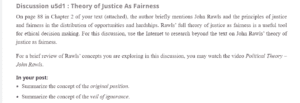Theory of Justice as Fairness
The theory of Justice as Fairness, developed by John Rawls, argues that justice is the first virtue of every social institution. This means that any ethical society is developed using structures of enhancing justice and fairness to all people. Accordingly, it is essential to evaluate the concepts of this theory and how they apply to society today.
Summarize the concept of the original position.
The original position is a hypothetical situation representing the state of nature before it is affected by political and social issues affecting society. In the original position, the system of society is placed in a manner of justice that adequately provides support, even for the lowest demographic groups in society (Murphy, 2017).
Summarize the concept of the veil of ignorance
A veil of ignorance is a state in which decisions about social justice are made. People tend to sit behind a veil of ignorance by making decisions about political issues when they do not have foreknowledge about the situation in that society, leading to making decisions that are not just and fair towards some social groups (Murphy, 2017).
Apply both concepts to an issue in today’s society that you feel is important.
A majority of societies today are democratic. Democratic systems establish power through the will of the people through the voting process. However, these systems tend to be flawed sometimes. The original position is a situation where people have not made any decisions about the political structures they want to establish. The veil of ignorance comes in when people’s opinions are biased by their political affiliation or personal benefits they get rather than determining the whole system of justice and how their decisions affect society. This, in turn, leads to voting for poor leadership, which in turn, is detrimental to society.
References
Murphy, L. B. (2017). Institutions and the Demands of Justice. In John Rawls (pp. 3-44). Routledge.
ORDER A PLAGIARISM-FREE PAPER HERE
We’ll write everything from scratch
Question
Discussion u5d1 : Theory of Justice As Fairness
On page 88 in Chapter 2 of your text (attached), the author briefly mentions John Rawls and the principles of justice and fairness in the distribution of opportunities and hardships. Rawls’ full theory of justice as fairness is a useful tool for ethical decision making. For this discussion, use the Internet to research beyond the text on John Rawls’ theory of justice as fairness.
For a brief review of Rawls’ concepts you are exploring in this discussion, you may watch the video Political Theory – John Rawls.

Theory of Justice as Fairness
In your post:
- Summarize the concept of the original position.
- Summarize the concept of the veil of ignorance.
- Apply both concepts to an issue in today’s society that you feel is important.
Your post must include information from your research from the Internet, not just from the text, and be at least 100 words.
Refer to the Discussion Participation Scoring Guide for posting expectations.
Discussion Participation Scoring Guide
| Discussion Participation Grading Rubric | ||||
| Criteria | Non-performance | Basic | Proficient | Distinguished |
| Applies relevant course concepts, theories, or materials correctly. | Does not explain relevant course concepts, theories, or materials. | Explains relevant course concepts, theories, or materials. | Applies relevant course concepts, theories, or materials correctly. | Analyzes course concepts, theories, or materials correctly, using examples or supporting evidence. |
| Collaborates with fellow learners, relating the discussion to relevant course concepts. | Does not collaborate with fellow learners. | Collaborates with fellow learners without relating discussion to the relevant course concepts. | Collaborates with fellow learners, relating the discussion to relevant course concepts. | Collaborates with fellow learners, relating the discussion to relevant course concepts and extending the dialogue. |
| Applies relevant professional, personal, or other real-world experiences. | Does not contribute professional, personal, or other real-world experiences. | Contributes professional, personal, or other real-world experiences, but lacks relevance. | Applies relevant professional, personal, or other real-world experiences. | Applies relevant professional, personal, or other real-world experiences to extend the dialogue. |

